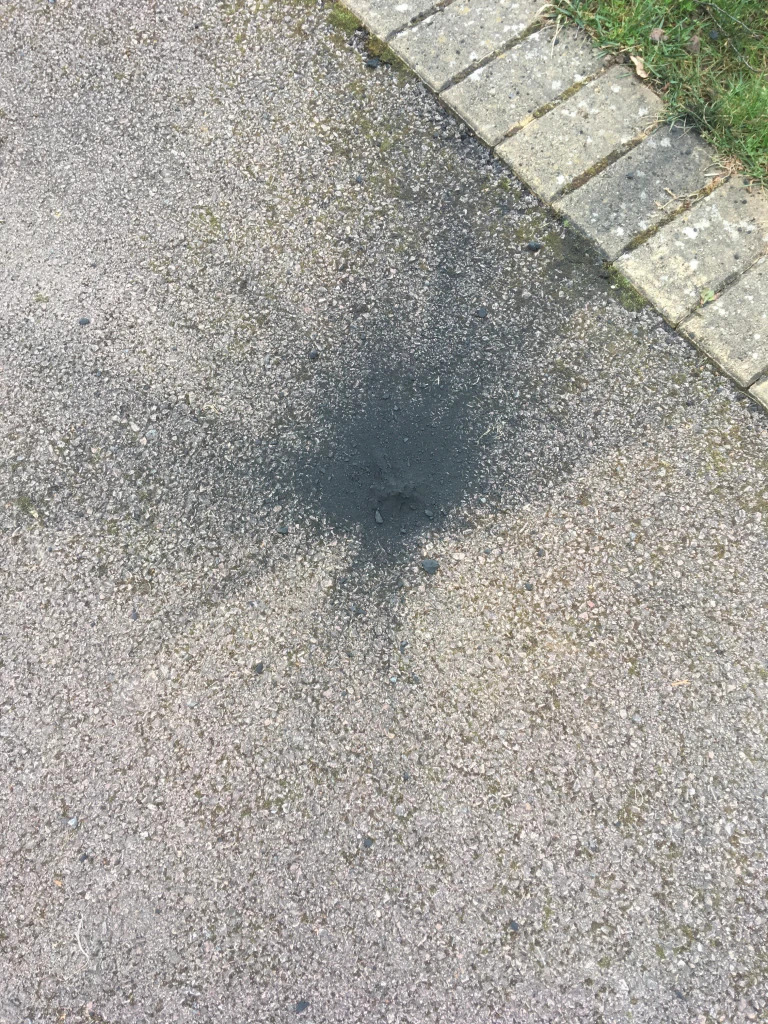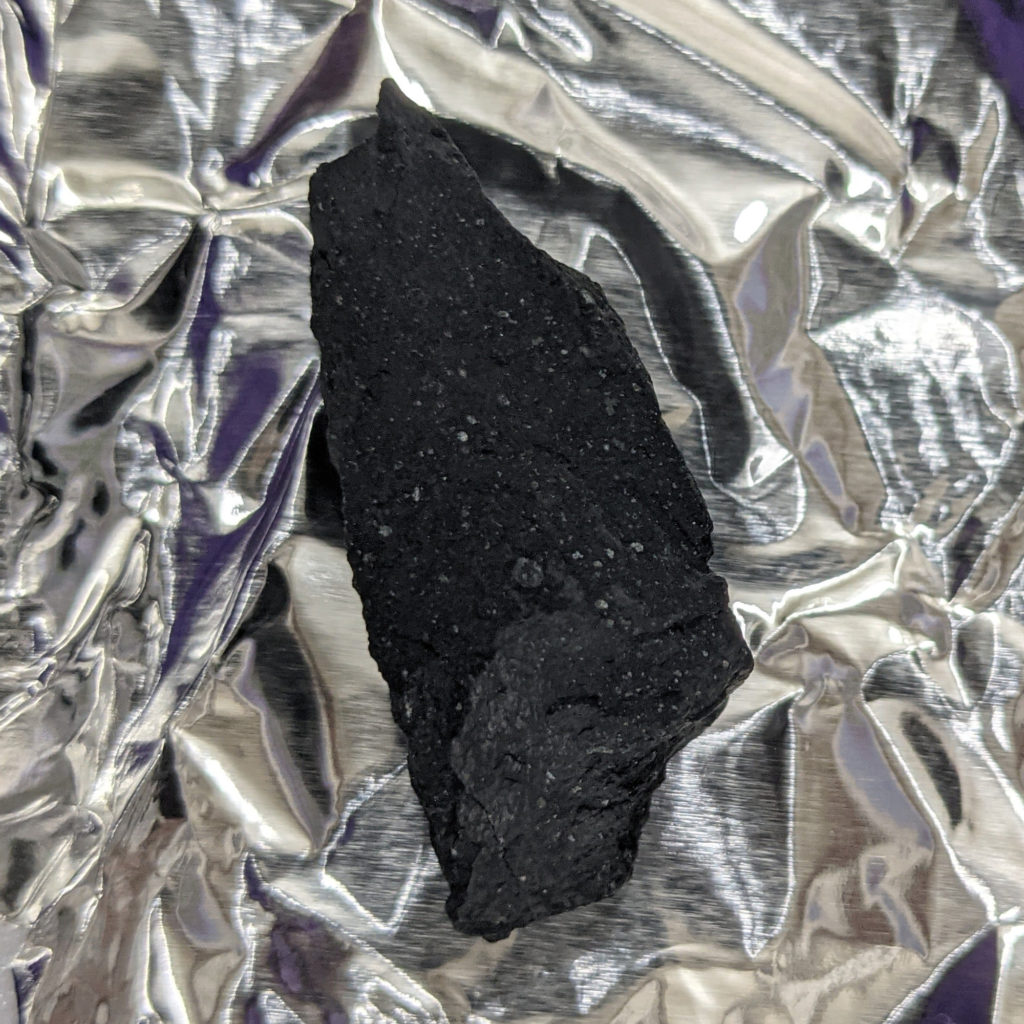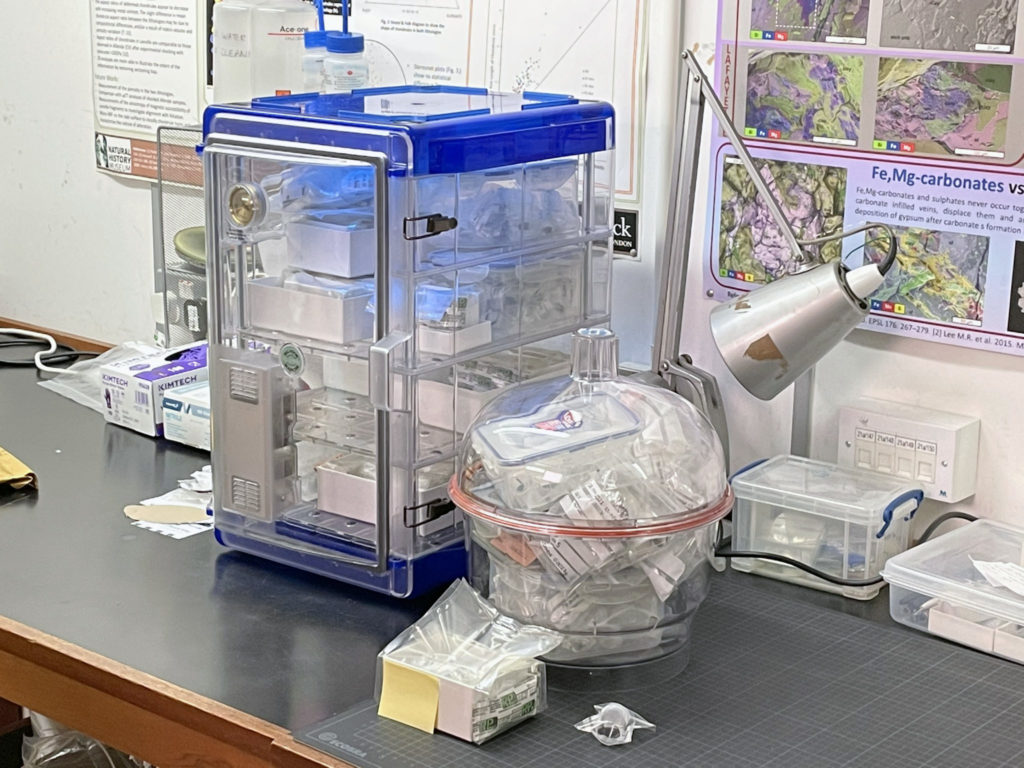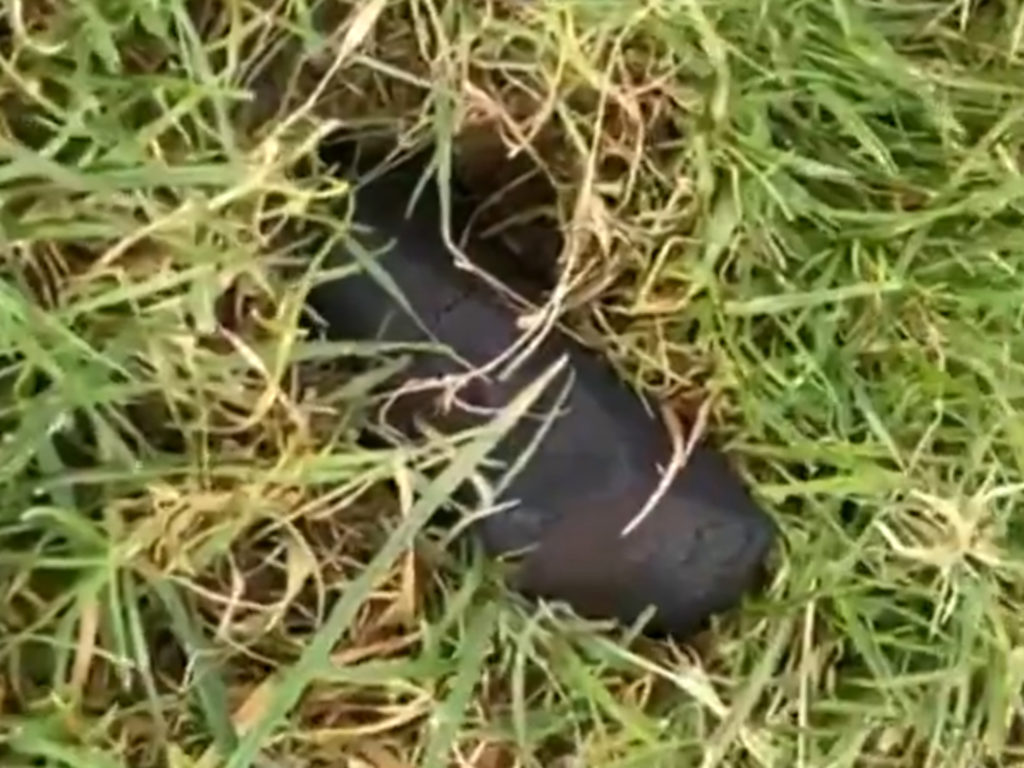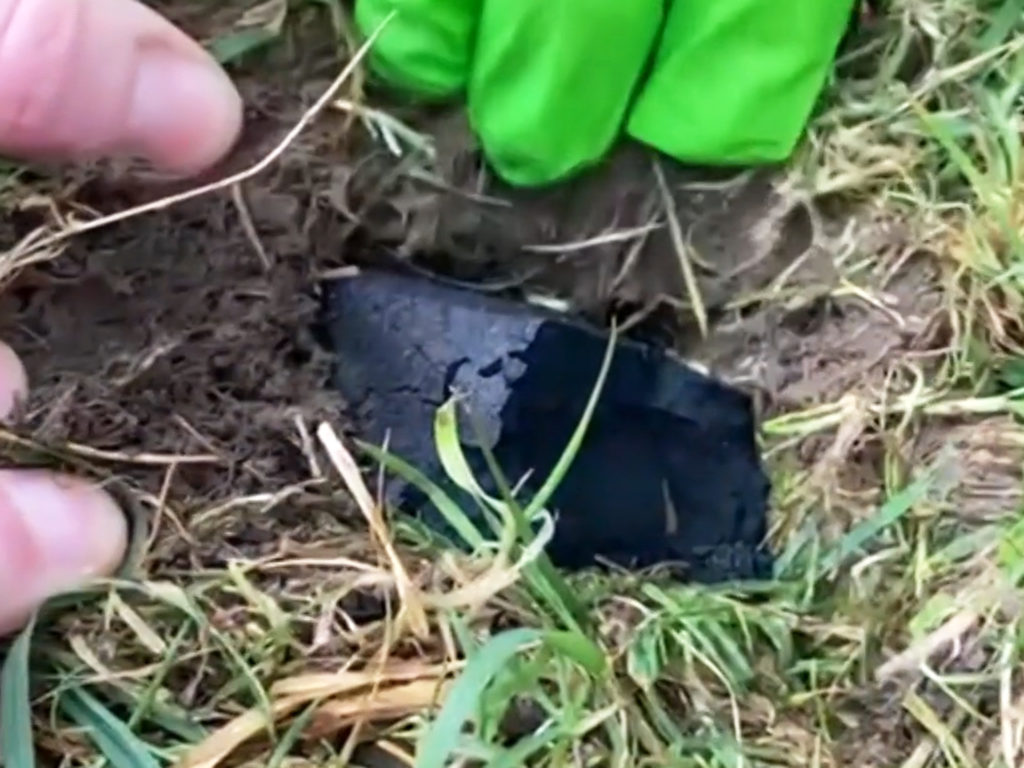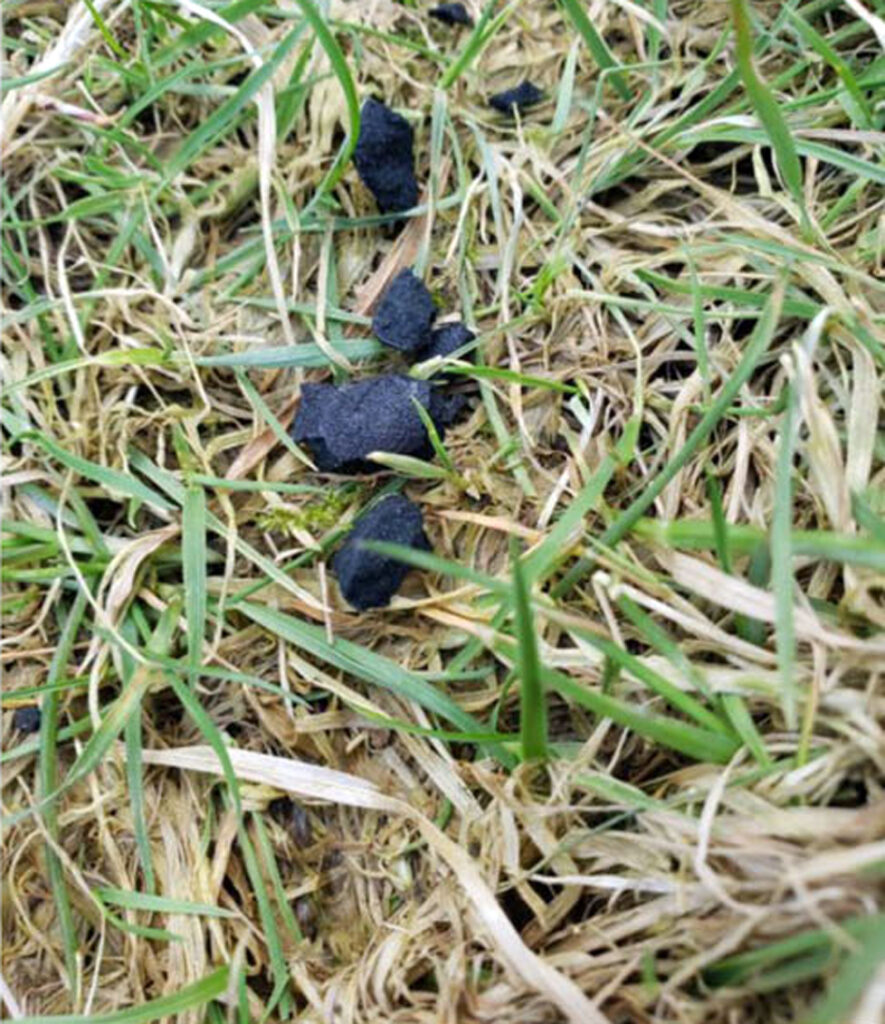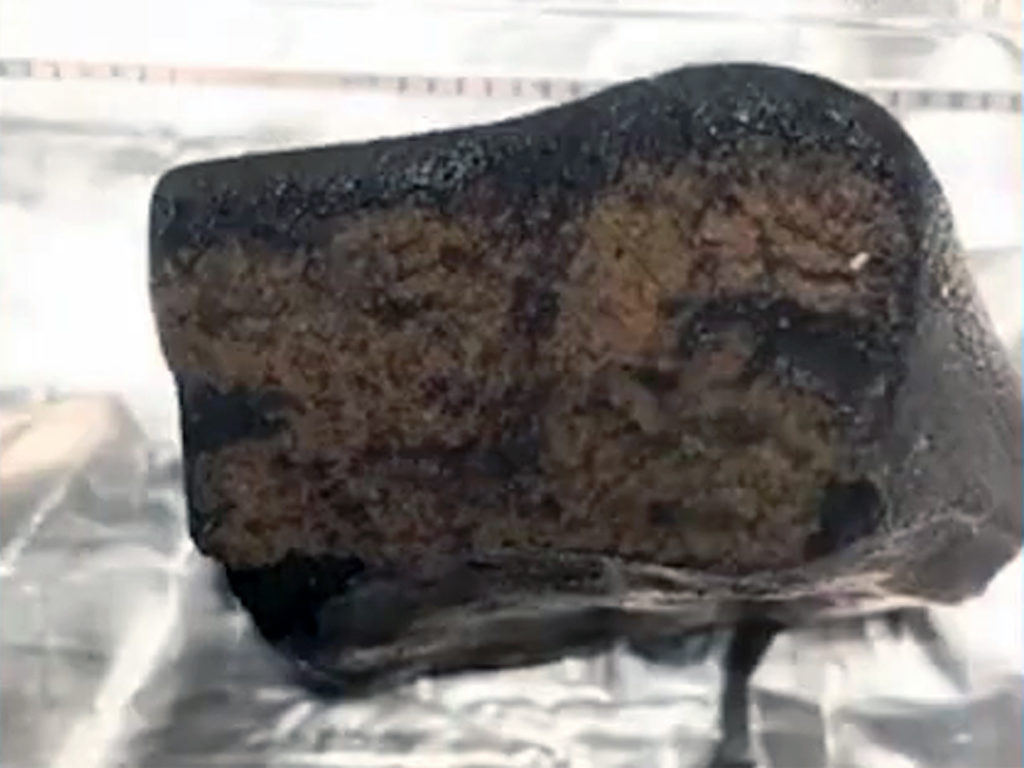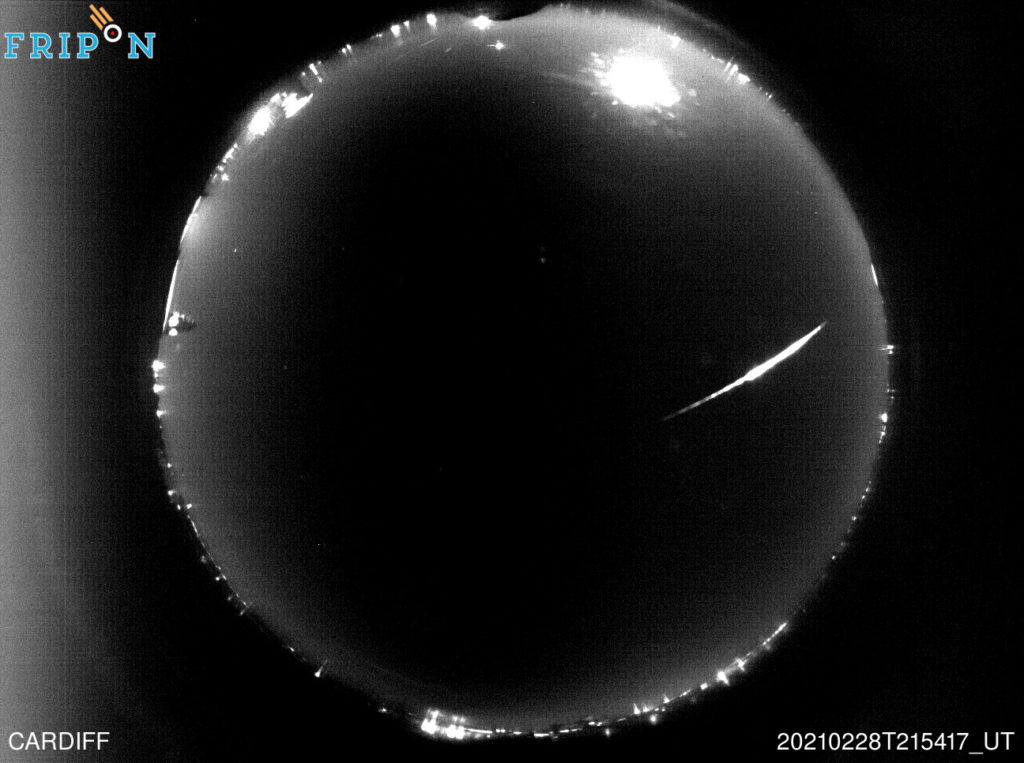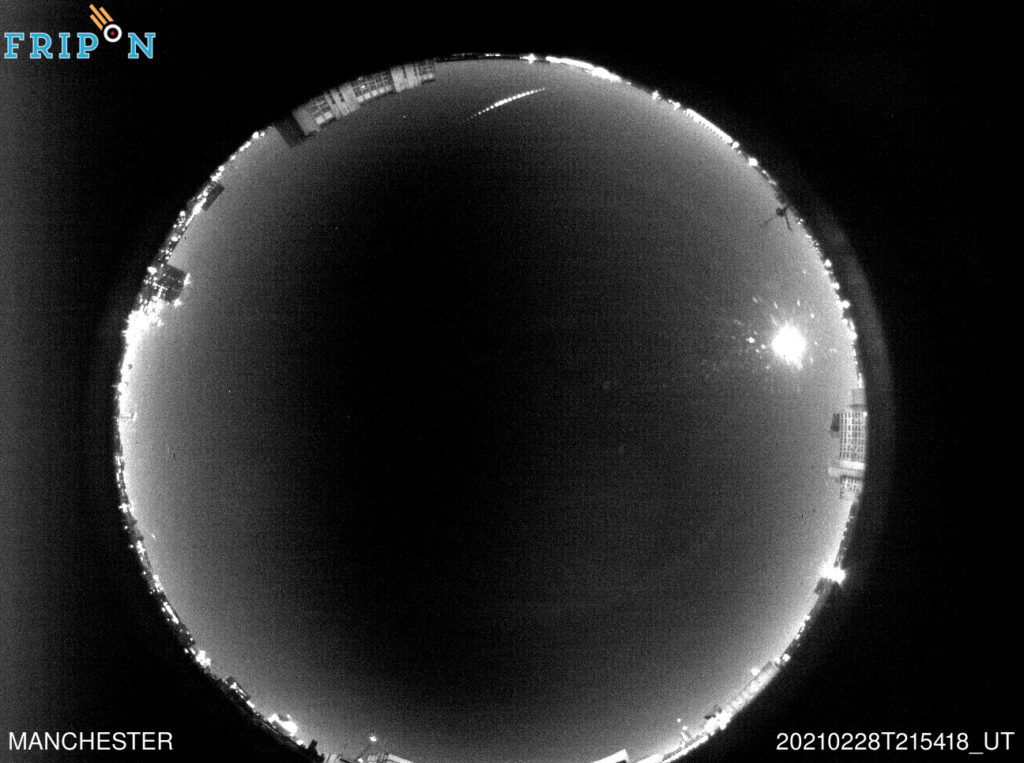WINCHCOMBE meteorite fall (CM2, ~601.9 grams, 9 masses) in Winchcombe, Woodmancote and Bishop’s Cleeve, Tewkesbury Borough, Gloucesteshire, UK on 28 February 2021 at 21.54:15.88 – 21.54.24.12 UT
Last update: 28 February 2023
A CM2 chondrite fell on the Wilcock family’s driveway in Winchcombe at location 51°57’04.4″N 1°58’32.5″W, Tewkesbury Borough, Gloucestershire, UK on 28 February 2021 at 21.54:15.88 – 21.54.24.12 UT. The Wilcock family, school governor Rob, his wife Cathryn, a retired teacher, and their 25-year-old daughter Hannah were downstairs at their home watching TV. Through her open window on the first floor only Hannah heard a loud clattering sound outside which reminded her of a ‘photo frame shattering’. Hannah got up and looked out of the window but because of the dark she could not see anything outside. In the morning, between 7 and 8 a.m. Hannah saw the dust ‘stain’ on the drive when she opened the curtains of her bedroom window on the first floor. Then also Cathryn saw the pyramidal dust patch with a ‘splat sign all around it’ on the driveway through the lounge window on the ground floor. When Hannah came down they discussed their observations. They knew it had not been there the evening before. When Cathryn and Hannah went out they saw the 7- to 10-centimetre wide small pile of the almost completely shattered meteorite outside on the driveway, about half way between the house and their parked car. Small fragments had been ejected all over the lawn and the driveway. First they thought it was a piece of charcoal or remains of a barbecue which someone had thrown or dumped onto their driveway. Rejecting this improbable idea Rob posted a photo about his find in the family’s private social media group which made his son Daniel in Leeds answer and inform him about recent reports of a bolide above the area. Then Rob knew what had happened. At around 9.30 a.m., after taking several photos, he conscientiously and thoroughly collected 319.5 grams of dust (~ 40-50 grams) and smaller fragments (the biggest fragment weighing 7.3214 grams) of the meteorite from the driveway and the lawn and put them in a clean Waitrose freezer plastic bag and some yoghurt-pots. Some bigger meteorite fragments were found up to ten metres away from the fall site. Later during the day Rob contacted the UK Meteor Observation Network which passed their request on to the Natural History Museum in London. Dr Richard Greenwood, Research Fellow in Planetary Sciences at the Open University, was the first to confirm the meteoritic nature of the found fragments at around 3 p.m. in the afternoon of 3 March. He immediately contacted Dr Ashley James King, UK Research and Innovation Future Leaders Fellow in the Department of Earth Sciences at the Natural History Museum in London who immediately took the next train to Winchcombe. After arriving at around 8 p.m. he went to the Wilcocks’ house and from 8.30 p.m. spent about two hours inspecting and weighing the meteorite fragments on the Wilcocks’ kitchen scale in the evening. Later during the day several hours were spent on picking up all the remaining small fragments from the driveway and adjoining lawn. Additionally some reference samples of terrestrial soil near the fall location were collected. A 17.2-gram specimen and some fragments (~ 3 grams) were found on a neighbor’s driveway. Between 29 February and 28 March 2021 Rob Wilcock found another ~9 grams of ~35 small sub-gram fragments on the lawn which he eventually had sold from March 2022. On 8 September 2021 an intact square section of the driveway tarmac containing the impact dent was carefully cut out. It was inspected at the Natural History Museum London on 3 November and will be on public display there, possibly together with the 150-ml ‘double cream’ pot which was initially used to collect the meteorite fragments. The Wilcock family has decided to put a commemorative plaque at the impact location which says ‘The Winchcombe Meteorite landed here at 21:54 on 28th February 2021’. On 6 March, at or around 9.39 a.m., an intact 152-gram specimen (which broke in at least two bigger fragments (103.1g and 48.9g) while being removed from the mud by Dr Luke Daly and Dr. Lydia Hallis) was found by the young Hungarian woman Míra Bianka Ihász in its 5-centimetre deep impact pit in a sheep field of 57-year old Victoria Bond’s 200-acre Rushbury House farm, probably around location 51°56’58.8″N 2°00’36.8″W, about 2.38 kilometres west of the Wilcock fall site and about 2.58 kilometres eastnortheast of the fall location of the Carrick mass (51°56’33.9″N 2°02’45.6″W), see our three-mass Winchcombe strewn field map below. Ihász was walking behind the Glasgow University search team and had just decided to catch up with them when she noticed a shiny object with an unusual shape from a distance of about three metres. Being unsure whether it actually was a meteorite she called Luke Daly who told her ‘This is it!’. The team celebrated their find with a bootle of Lagavulin 16-year single malt scotch whisky which the team had been given by a local. The larger 103-gram fragment has been on public display inside a desiccator in the ‘Vault’ of the Minerals gallery at the Natural History Museum in London since 17 May 2021. Ihász had just joined her partner Dr Luke Daly, Aine O’Brien, and Dr. Lydia Hallis, a group of scientists of the School of Geographical and Earth Sciences at the University of Glasgow on their systematic meteorite search in the calculated ~ 4 km² fall area (4-9 March). Including her find and apparently three other specimens (~5-10 grams, total mass 31 g) found in gardens and on driveways in Woodmancote and some specimens and fragments (0.02 – 7.5 g, total mass of 16 grams) found on 16 March in a field to the southwest of the village of Bishop’s Cleeve, officially about 548 grams in total have been found by locals and about 15 to 20 scientists from The Natural History Museum London, The University of Glasgow, The University of Manchester, The Open University, The University of Plymouth and Imperial College London. The systematic field search campaign of the scientists which started on 4 March lasted for five days.
“The importance about all of this is not about getting rich. It’s the scientists getting rich information that they can work on. It’s disappointing to read so much in the papers about the money side of it.” (Rob Wilcock)
Due to the meteorite’s scientific significance and its educational value to young people, who can be inspired by learning about meteorites, the Wilcock family has kindly donated 313 grams of meteorite fragments to the national meteorite collection, curated at the Natural History Museum in London, and two other museums. Mira Ihasz’s find, the biggest but unfortunately broken meteorite mass of the Winchcombe fall so far, has equally been donated to the Natural History Museum by the 57-year old farm owner Victoria Bond (and 29-year old Lachlan Bond). The Bonds, the Wilcock family and the locals who had found three other meteorites were informed that they were the owners of the meteorites because they had fallen on their property. This makes the donations of their five meteorites to science even more remarkable. They deserve great appreciation of the scientific community and general public. About three kilometres away from the Wilcock fall site another small meteorite specimen with an estimated diametre of about 3 centimetres was found by David and Valerie Carrick in their garden in Woodmancote while looking for some cat poo which they wanted to remove. The majority of the found meteorites and fragments, currently being stored in a vacuum desiccator, are being analysed and have been classified at the NHM London where they will be curated in the future. The classification was finished by late evening of 4 March. A Winchcombe meteorite consortium of scientists has been established to study the meteorite. The NHM and several universities have been doing analyses on fragments of the Winchcombe meteorite, among those the universities of Edinburgh, Leicester, Bristol, Plymouth and the Open University. An oxygen isotope analysis has been performed by Open University PhD student Ross Findlay. An X-ray fluorescence (XRF) analysis has been performed at the Natural History Museum in London. Analyses of organic phases/carbonates within the meteorite have been performed. The CRE-age of the Winchcombe meteorite has been determined. According to Dr Luke Daly scientists even consider plans to seal some Winchcombe fragments in vials or glasses filled with different ‘atmospheres’ (vacuum, nitrogen, argon etc.) for a century-long experiment to determine the influence of the gases on a CM chondrite during this time. I-Xe analyses in Manchester have been planned as well. The Wilcock family has donated three fragments of the meteorite to the Winchcombe Museum where they have been exhibited in a glass cabinet since 1 September 2021. The NHM used these specimens to create a CT scan and a thin section for the future display in the Winchcombe and/or Cheltenham museum. The Wilcock driveway fall site has been covered with a plastic foil and a wooden frame to protect the dark traces of the shattered meteorite from precipitation as it might be cut out so that it can be displayed in a museum together with the meteorite in the future. Other found specimens (~53.9 grams) have inofficially been reported by some private and commercial meteorite searchers. In March 2021 more masses were found. On 16 March several specimens and fragments weighing 16 grams were found by Sarah Farrelly, Ieuan Spencer, Sheeraz Naqvi, Benjamin Mayne, Daniel Skilton and Dan Kirk in a solar park south-west of Bishop’s Cleeve. Chris Casey found one specimen weighing 12 grams on 21 March and on 23 March 2021 he found another two fragments of a 17.5-gram specimen in the grass of the public park “The Grange” in Bishop’s Cleeve. On 25 March three fragments weighing 19.2 grams were found by Chris Casey and Luther Jackson on the grass verge of a footpath in Two Hedges Road in Bishops Cleeve. Apparently the fragment had been driven over. Another 5.2-gram mass which fragmented on impact was found by Luther Jackson on a footpath in the West of Bishop’s Cleeve, by the A435 on 1 April. There are hundreds of eyewitness reports and several security cam, dashcam and skycam video recordings of the bolide. Fifteen fireball or meteor cameras of six networks recorded the event: SCAMP/FRIPON (three cams), UKFN/DFN (three cams), AllSky7 (two cams: Ben Stanley and Luc Bastiaens), Global Meteor Network (two cams: Mark and Mary McIntyre and Paul Dickinson (Hullavington) ), and cams from NEMETODE (Network for Meteor Triangulation & Orbit Determination) and UKMON, the UK Meteor Observation Network, (Nick James, Alan Shuttleworth, Derek Robson (through spectroscopic grating), Richard Fleet, Dave Jones, Steve Bosley and Peta Bosley). Winchcombe (CM2) was officially registered as ‘confirmed fall’ in the Meteoritical Bulletin database on 3 July 2021.
The known 7.87-kilometre Winchcombe strewn field
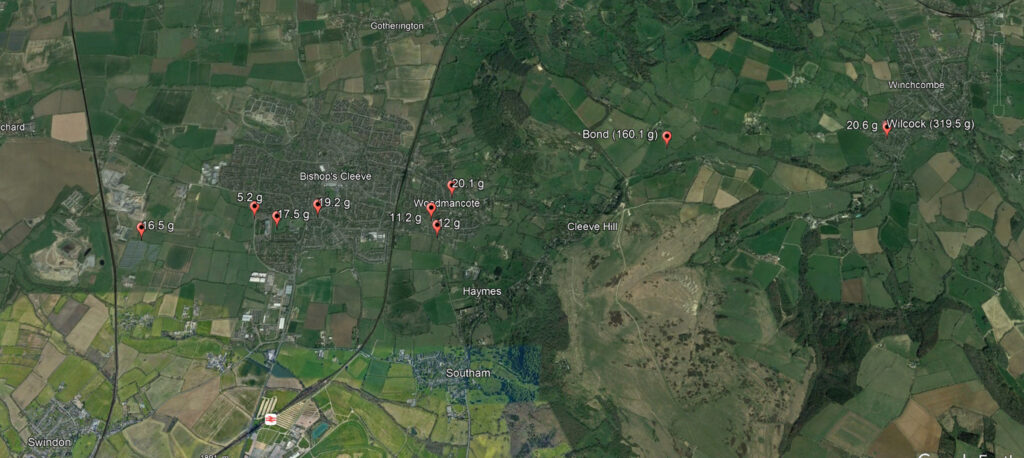
The exact and approximate known fall location of the found meteorite masses, based on our own research and data published by S. Russel et al. in MAPS on 26 February 2023. Image: karmaka
The Wilcock fragments (319.5 grams) of the Winchcombe meteorite
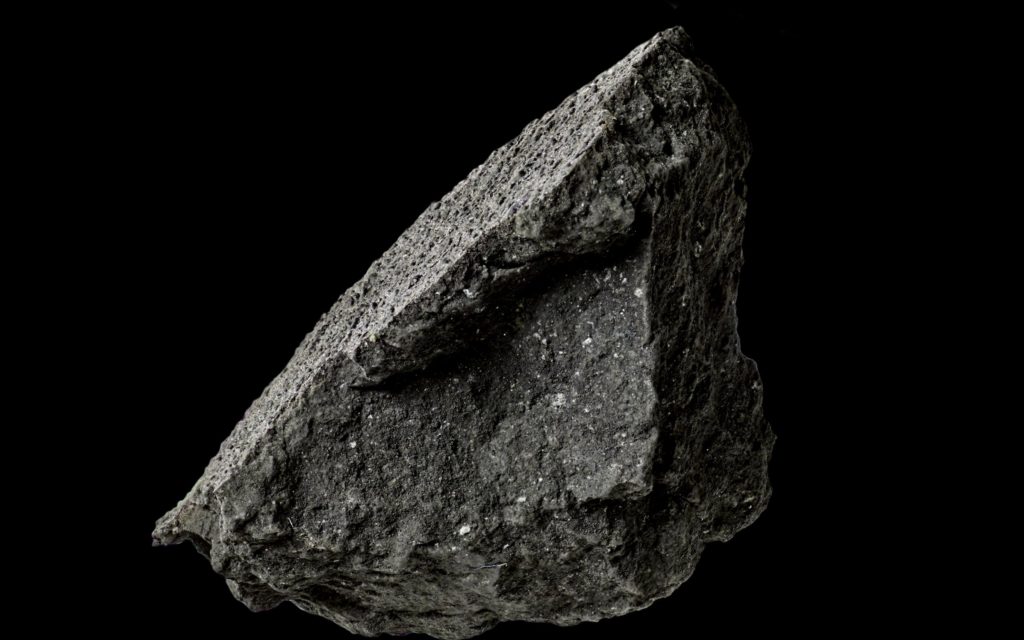
One of the found fragments (~ 20 x ~15 mm). Photo: NHM
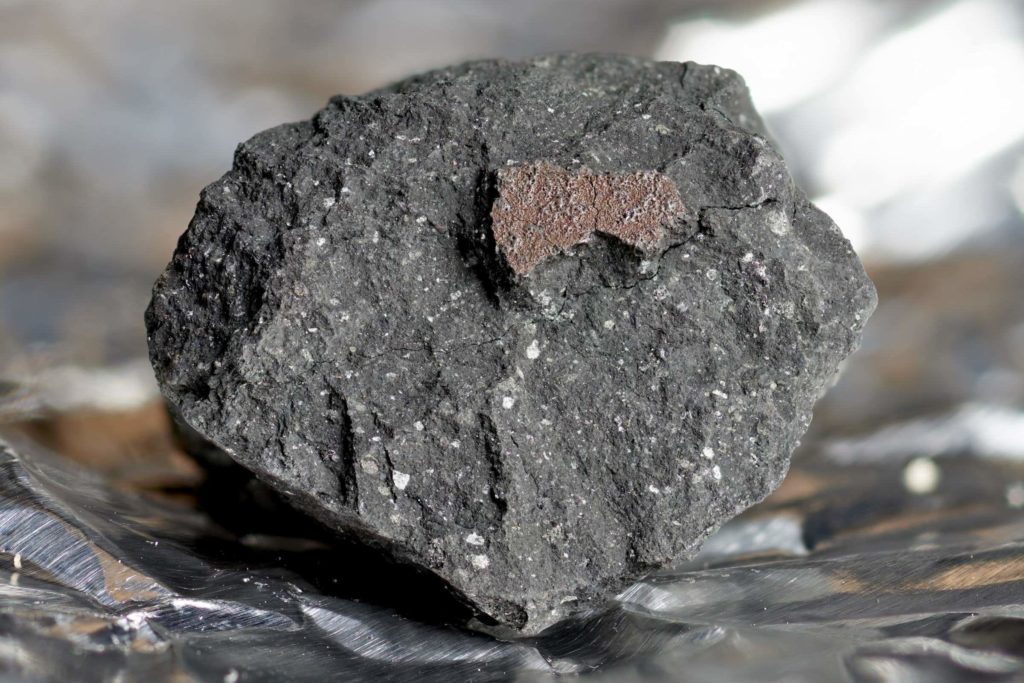
One of the meteorite fragments (~5 grams, ~ 15 x ~20 mm) with a patch of brownish fusion crust. Photo: Jonathan E Jackson / NHM
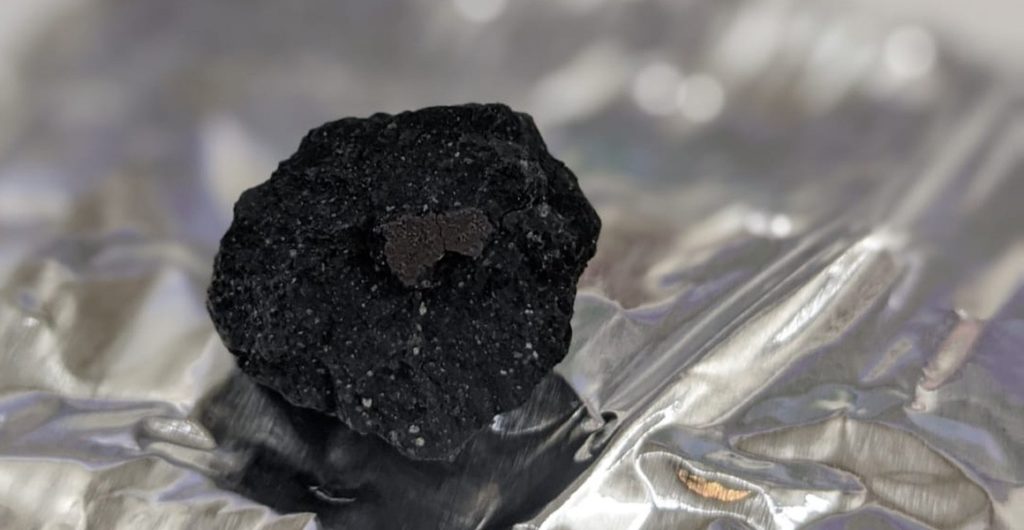
One of the meteorite fragments (~ 4 grams, ~ 15 x ~20 mm). Photo: NHM

One of the meteorite fragments. Photo: NHM
Fragments of the Winchcombe meteorite at the Natural History Museum, London. Photo: NHM

A fragment (~2 cm across) reported to weigh about 5 grams. Image: Open University

Fragment of the Wilcock mass of the Winchcombe meteorite at the Natural History Museum, London. Image: BBC

Larger fragment of the Wilcock mass of the Winchcombe meteorite at the Natural History Museum, London. Image: Wilcock family

The shattered meteorite on the driveway (Up is ~SSW). Photo: Wilcock family

The shattered meteorite on the driveway. Photo: Rob Wilcock

The shattered meteorite on the driveway (Up is ~SSE). Photo: Rob Wilcock

Meteorite dust traces on the driveway (up is ~east) after the removal of the meteorite fragments and dust. Photo: The Open University
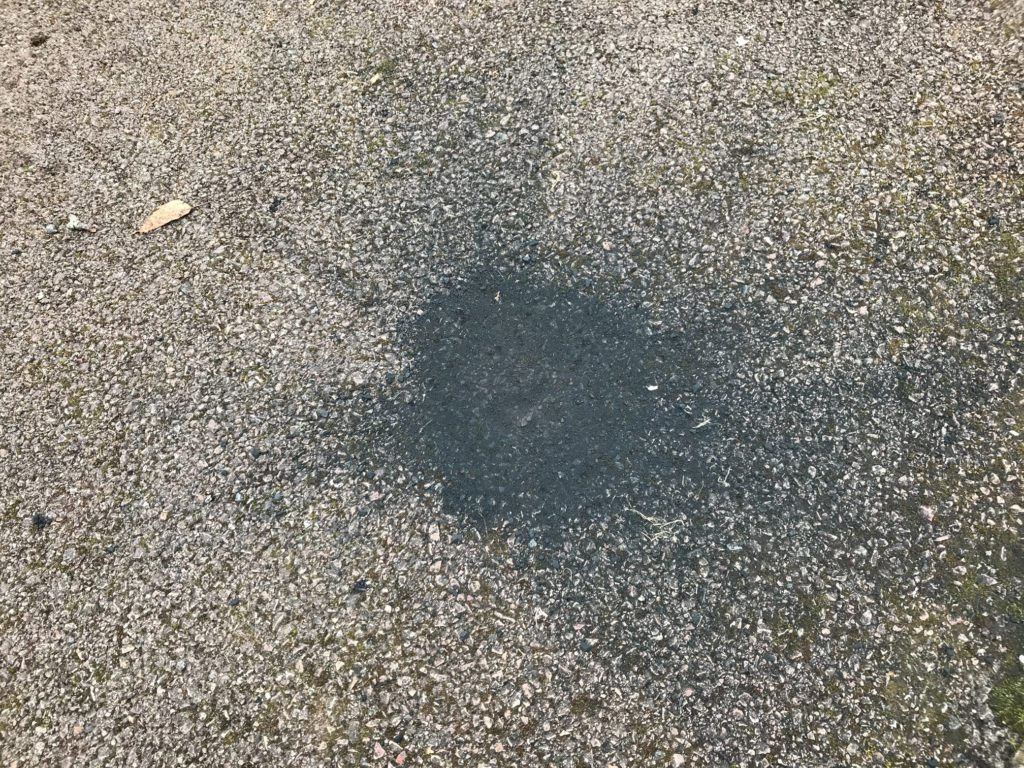
Meteorite dust traces and reportedly a small dent on the driveway (up is ~east) after the removal of the meteorite fragments and dust. Photo: The Open University

One ~4-centimetre long shallow indentation with a maximum depth of about 1 centimetre next to a smaller round one (Ø ~1 cm) at the location where the meteorite hit the driveway. Image: BBC

Two shallow indentations where the meteorite hit the driveway. Image: BBC

One of the driveway fragments on 1 March 2021. Photo: Rob Wilcock

The plastic bag containing the larger driveway fragments (3 to 7 grams) collected by the Wilcock family being weighed on the Wilcocks’ kitchen scale. Photo: Wilcock family.
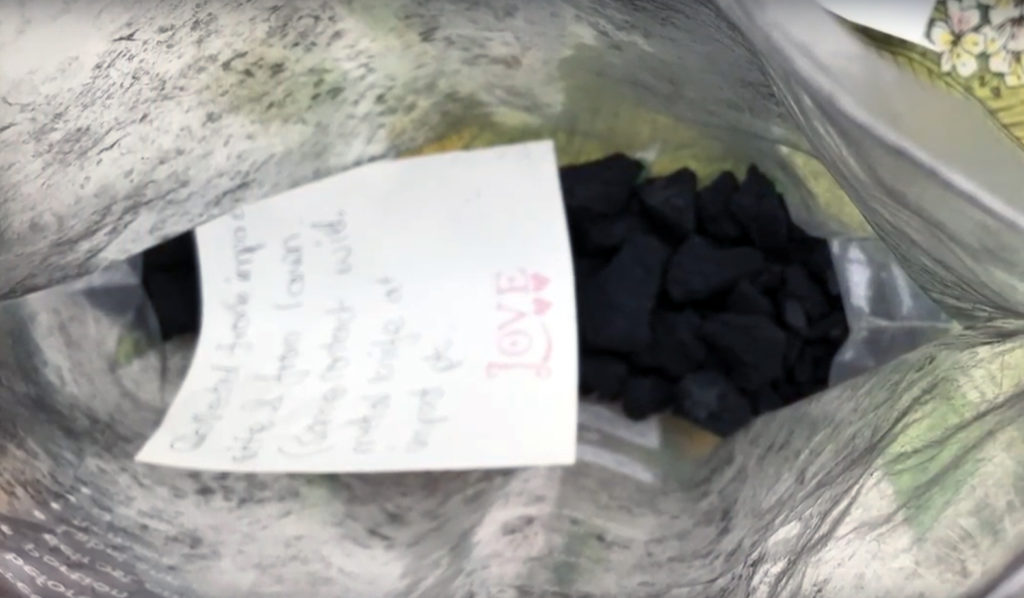
A look inside the plastic bag containing the larger fragments of the mass which fell on the driveway. Image: Open University
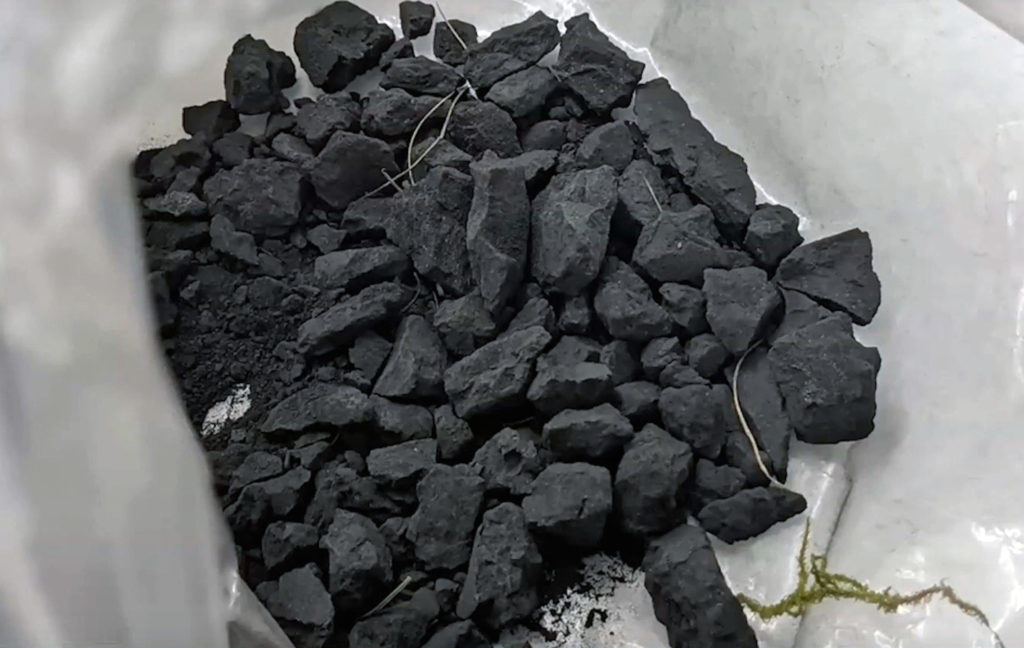
Fragments and dust of the Wilcock mass before being weighed and registered. Photo: Dr Helena Bates
Smaller fragments at the Natural History Museum, London. Video: NHM

Weighed, registered and bagged smaller fragments and dust of the Winchcombe masses at the NHM. The Wilcocks’ used plastic bag, yoghurt-pots, the Wilcocks’ handwritten notepad and the toothbrush and brush used to collect the fragments from the driveway have been archived as well. Photo: Dr Helena Bates

Larger fragments (3-7 grams) of the Wilcock mass are being stored in small card containers at the NHM. Photo: Dr Helena Bates
The Bond (Rushbury House farm) mass, 160.1 grams in total
The third meteorite (152.0 grams, with crumbs 160.1 g in total) was found by Míra Bianka Ihász and a search team of scientists of the School of Geographical and Earth Sciences at the University of Glasgow at or around 9.39 a.m. on 6 March 2021 in its 5-centimetre deep impact pit on a sheep field of Victoria Bond’s 200-acre Rushbury House farm, probably around location 51°56’58.8″N 2°00’36.8″W, about 2.38 kilometres west of the Wilcock fall site. The initially intact specimen broke in two fragments (103.1 g and 48.9 g) when removed from its impact pit. The 103-gram fragment is currently on public display inside a desiccator in the ‘Vault’ of the Minerals gallery at the Natural History Museum in London. Farm owner Victoria Bond is considering putting a commemorative plaque at or near the find location in the field.
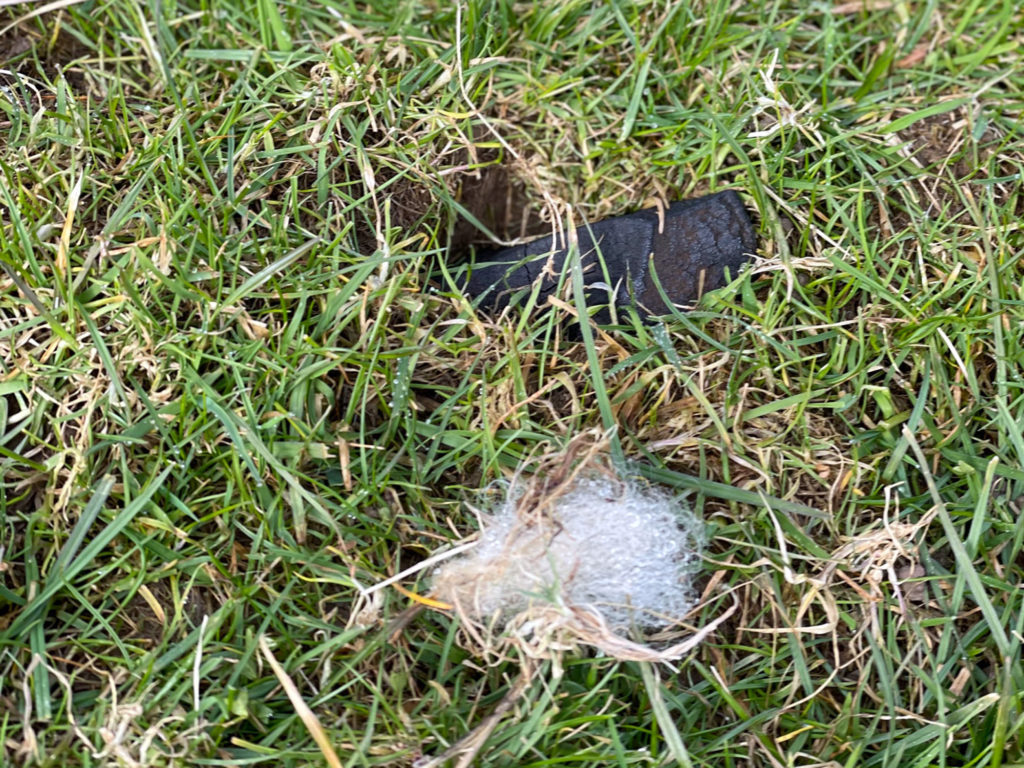
The intact elongated Bond (sheep field) mass (152 grams) in situ in its 5-centimetre deep impact pit (up is ~west). Photo: Áine O’Brien

The intact elongated meteorite (152 grams) in situ (up is ~north). Photo: Natural History Museum
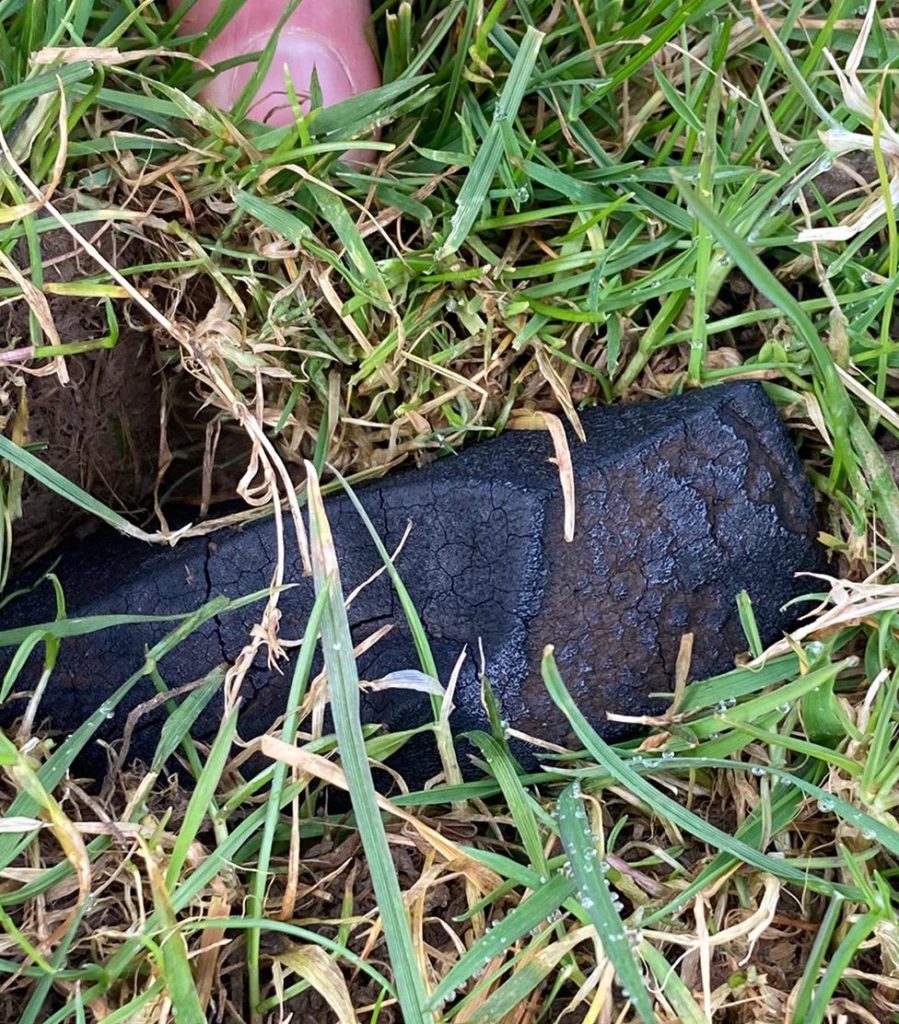
The intact elongated meteorite (152 grams) with contraction cracks in its fusion crust (up is ~west). It fell on the sheep field of the Rushbury House farm. Photo: Glasgow University
Visual reenactment of Míra finding the Bond mass among the omnipresent sheep faeces on 6 March 2021. Video: Míra Bianka Ihász
What looks similar to the omnipresent sheep faeces around the fall location is the intact 152-gram Bond specimen of the Winchcombe meteorite in situ, still partly embedded in the ground of a sheep field of the Rushbury House farm between Winchcombe and Woodmancote. Up is ~north in final image of the video. The specimen broke in about three fragments during its removal from the impact pit.

The larger 103-gram fragment still stuck in the mud of its impact pit after the smaller fragment had been broken off (up is ~southwest). Image: Luke Daly

The larger 103-gram fragment of the broken Bond (Rushbury House farm) mass showing contraction cracks in its fusion crust and its broken surface at the Natural History Museum, London. The fragment is currently on public display inside a desiccator at the NHM. Photo: Dr. Ashley King

The larger 103-gram fragment of the broken Bond (Rushbury House farm) mass showing contraction cracks in its fusion crust and its broken face at the Natural History Museum, London. Photo: Dr. Ashley James King

The larger 103-gram fragment of the broken Bond (Rushbury House farm) mass on display at the Natural History Museum from 17 May 2021. Photo: The Trustees of the Natural History Museum, London
360-degree video of Dr Katherine Joy and colleagues searching for Winchcombe meteorites in the fields. Video: Katherine Joy (published: 29 March 2021)
The solar park fragments (16.5 grams) west of Bishop’s Cleeve
Several stones and fragments were found by solar farm employees on 16 March. The team members were: Sarah Farrelly, Dan Kirk, Sheeraz Naqvi, Benjamin Mayne, Daniel Skilton, Ieuan Spencer.
Video of the recovery of one of the larger fragments which was found by Sarah Farrelly, Ieuan Spencer, Sheeraz Naqvi, Benjamin Mayne, Daniel Skilton and Dan Kirk in a solar park south-west of Bishop’s Cleeve on 16 March. Video: Michelle Kirk
The Carrick mass (11.2 g) from Woodmancote
Another small meteorite specimen with an estimated diametre of about 3 centimetres was found on 1 March by David and Valerie Carrick in their garden in Woodmancote while looking for some cat poo which they wanted to remove. According to our own research the mass was found at/very near location 51°56’33.9″N 2°02’45.6″W, that is about 2580 metres westsouthwest of the fall location of the Bond mass and about 4924 metres westsouthwest of the fall site of the Wilcock mass. Image: BBC
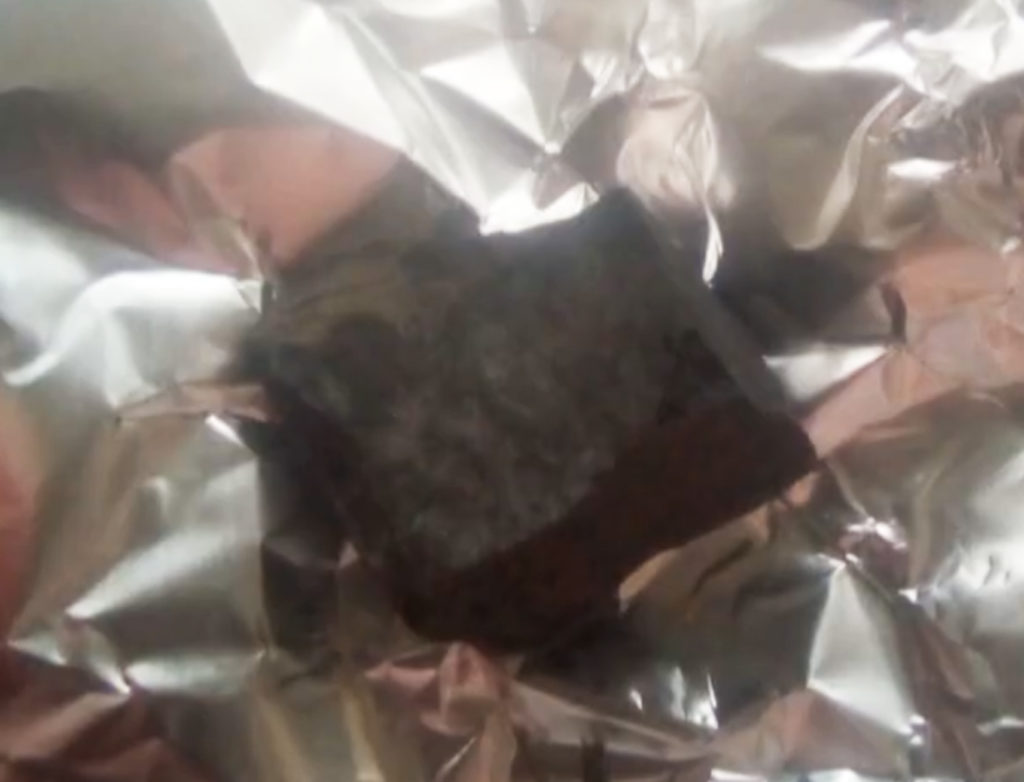
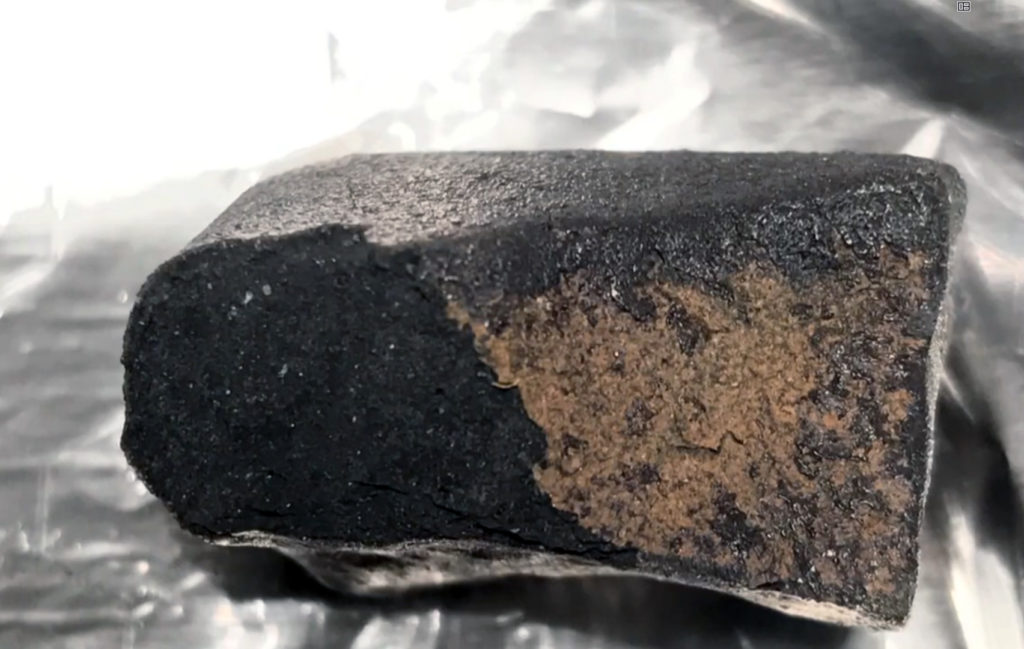
The second Winchcombe find, a small fragment (~2.5-3 cm across) found in Woodmancote on 1 March. The brightness of this photo has been increased to reveal more details of the specimen. Image: BBC
The EAARO find near Woodmancote
After 30 minutes of searching in the morning of 28 March fragments of another Winchcombe meteorite specimen were found embedded in the muddy ground of a field near Woodmancote by retired analytical chemist Derek Robson (EAARO’s Director of Astrochemistry) from Loughborough during a 7-person search expedition by the East Anglian Astrophysical Research organisation (EAARO). The found meteorite specimen was found broken into several fragments, either because it had been trodden by a farm animal or driven over by some farm machinery or because it fragmented on impact. A rectangular section of mud containing the embedded meteorite fragments was dug out, wrapped in aluminium foil and then delivered to a laboratory for appropriate curation.
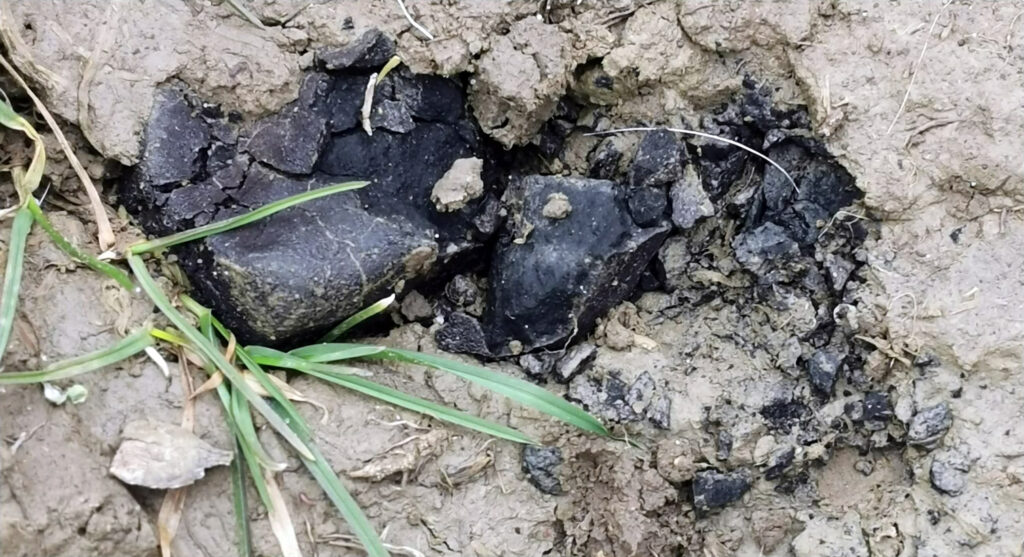
The fragmented EAARO specimen in situ on 28 March 2021. Photo: Derek Robson
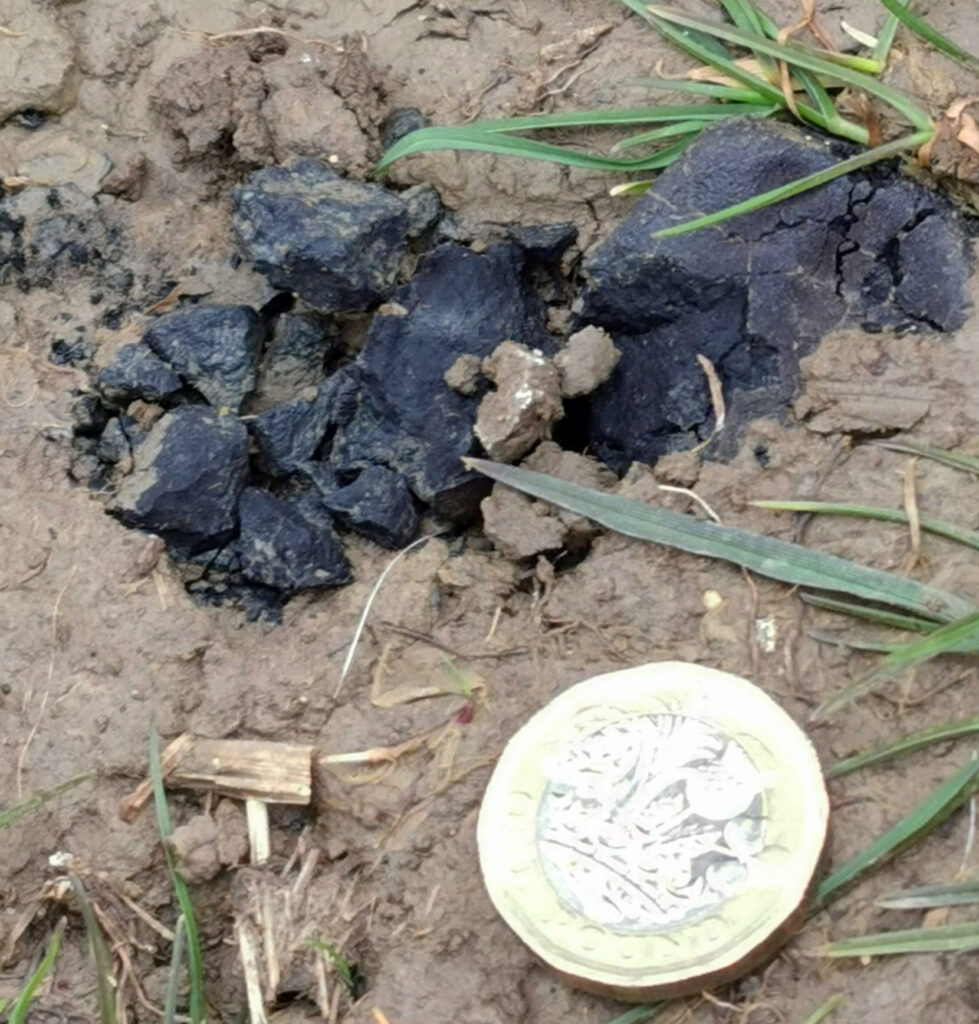
The fragmented EAARO specimen in situ on 28 March next to a £1 coin with a diameter of 23.43 mm. Photo: Derek Robson

The fragmented EAARO specimen in situ on 28 March next to a £1 coin with a diameter of 23.43 mm. Photo: EAARO
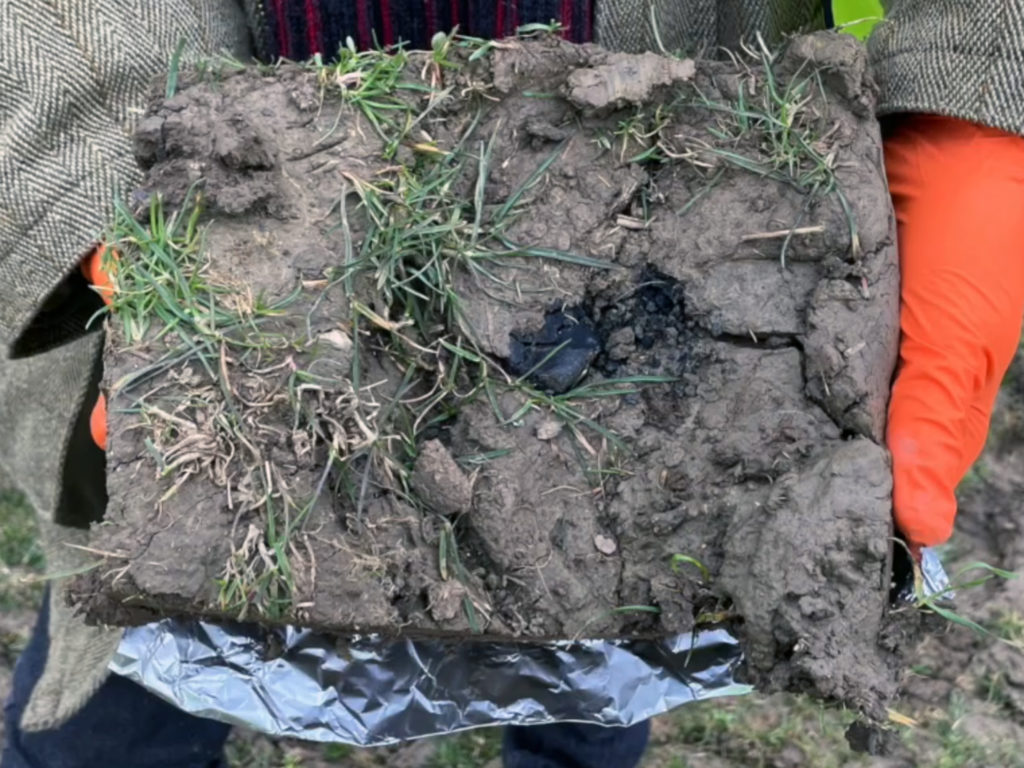
The cut out rectangular section of mud with the fragmented EAARO specimen in situ on 28 March. Photo: EAARO
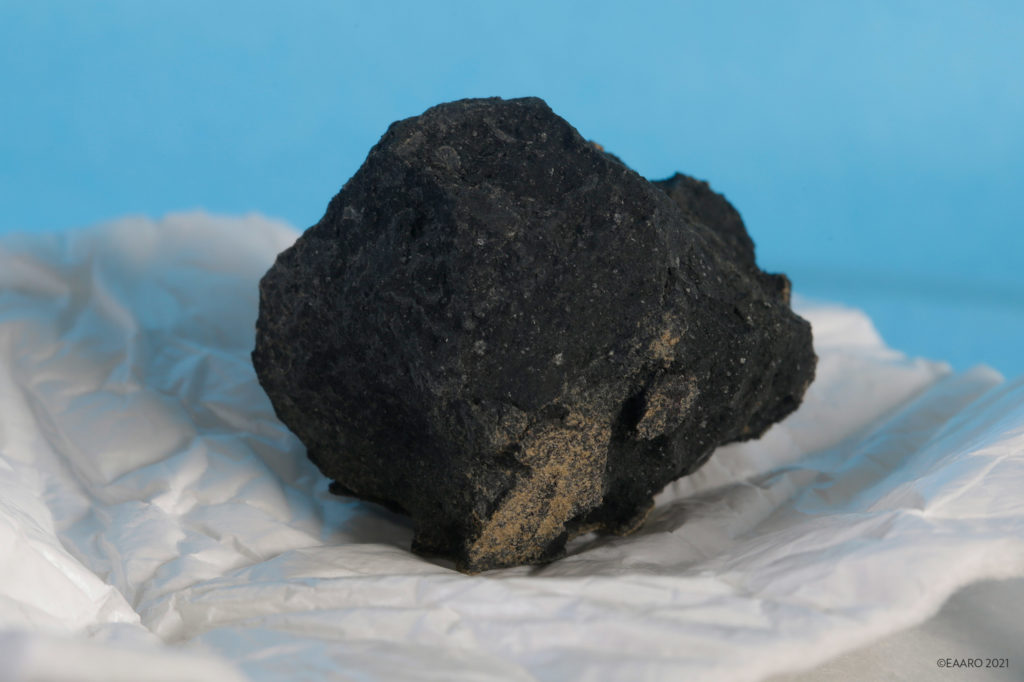
A fragment of EAARO’s find. Photo: EAARO/Dr David Clarke

A fragment of EAARO’s find. Photo: EAARO/Dr David Clarke

A fragment of EAARO’s find. Photo: EAARO
Fragment of EAARO’s Woodmancote specimen in an X-ray Computed Tomography scan. Video: University of Sheffield / East Anglian Astrophysical Research Organisation (EAARO).
Fusion crust of EAARO’s Woodmancote specimen in an X-ray Computed Tomography scan. Video: University of Sheffield / East Anglian Astrophysical Research Organisation (EAARO).
The bolide
Chronology from bolide’s detection to press release (28 February to 1st March), according to Magazine of the Geologists’ Association Vol. 20, No.2, June 2021, Dr Natasha Stephen (on 3 November 2021) and Ashley King (on 17 November 2021): 10 minutes after the bolide’s occurence at 10:04 p.m. a photo of the fireball was posted in social media by @PhotobyBen. At 22:13 UT Ray Taylor (Skirlaugh, North Yorkshire) of the Network for Meteor Triangulation and Orbit Determination (NEMETODE) reported the first visual sighting in an email to NEMETODE e-mail group, including Jim Rowe (UKFall). At 22:32 UT NEMETODE’s Adam Jeffers (Cookstown, Co. Tyrone, Northern Ireland) reported reported a third-party sighting of the bolide. At 22:37 UT Jim Rowe (UKFall) responded to NEMETODE confirming that the FRIPON/SCAMP cameras in Manchester, Cardiff and Honiton had registered the event. At 22:41 UT a third-party Instagram video by Alex Stoneman circulated within NEMETODE. At 22:51 UT Ivor Lafford’s doorbell camera recording from Milton Keynes was tweeted to UKMON. At 23:03 UT the first camera video from NEMETODE’s Nick James (Chelmsford, Essex, England) circulated within NEMETODE. At 3:30 UT on 1st March a HD video from AllSky7 camera at Nuneaton was sent to UKFALL by American Meteor Society and at 5:41 UT Dr Hadrian Devillepoix (DFN) commented “Lots of fragmentation, to a point where it is difficult to pick out the timing on the still images. The GFO camera in Wales is offline, but the other 3 in the area caught it (Lincoln, Mullard/Cambridge and Welwyn). Orbit is pretty cometary. Combined with the unusual amount of fragmentation, I’d say that makes it pretty interesting as we might be looking at a less common type of meteorite.” At 6:03 UT converted FRIPON data were sent to Dr Hadrien Devillepoix by UKFAll. The FRIPON trajectory solve showed a slow object reaching the low altitude of 30km. At 6:05 UKFAll response to American Meteor Society. At 6:12 UT message to all UKFALL team: “Last night’s huge fireball was both seen and heard all over southern England and beyond, and the initial FRIPON and DFN analysis indicates high fragmentation and a likely fall. I’ll get press releases and a strewn field together. This is likely already to be national news as it’s likely to break the world record for the most-reported meteor, and there are also multiple, excellent videos out there. Possibly looks like a bit of comet, so if anything did survive it could be highly unusual. At 6:53 UT UKFall’s Jim Rowe issued the first press release to members with the message “Because of lockdown we have the problem of getting anyone into the field. This event was also extremely widely seen and so is a national news story. So, I suspect we should go to national news media. As it’s probably on farmland near Cheltenham, let’s be less coy about the strewn field than usual. In fact let’s just publish it and ask farmers to keep an eye out. Here’s a quick first draft. Please amend as you see fit, then let’s get it out the door this morning”. At 7:25 UT the first meteor videos of UKFall members and the public came in and at around 8:00 UT media coverage began with interviews of Richard Kacerek (UKMON) on Sky and Ashley King on BBC News. At 8:25 UT an updated initial orbit calculation from the DFN came in, reflecting the FRIPON and UKFN data. At 9:30 UT a press release with the calculated strewn field was published.
The bolide above the Cotswolds captured by @PhotobyBen on 28 February (published 22:04 p.m.). Photo: PhotobyBen
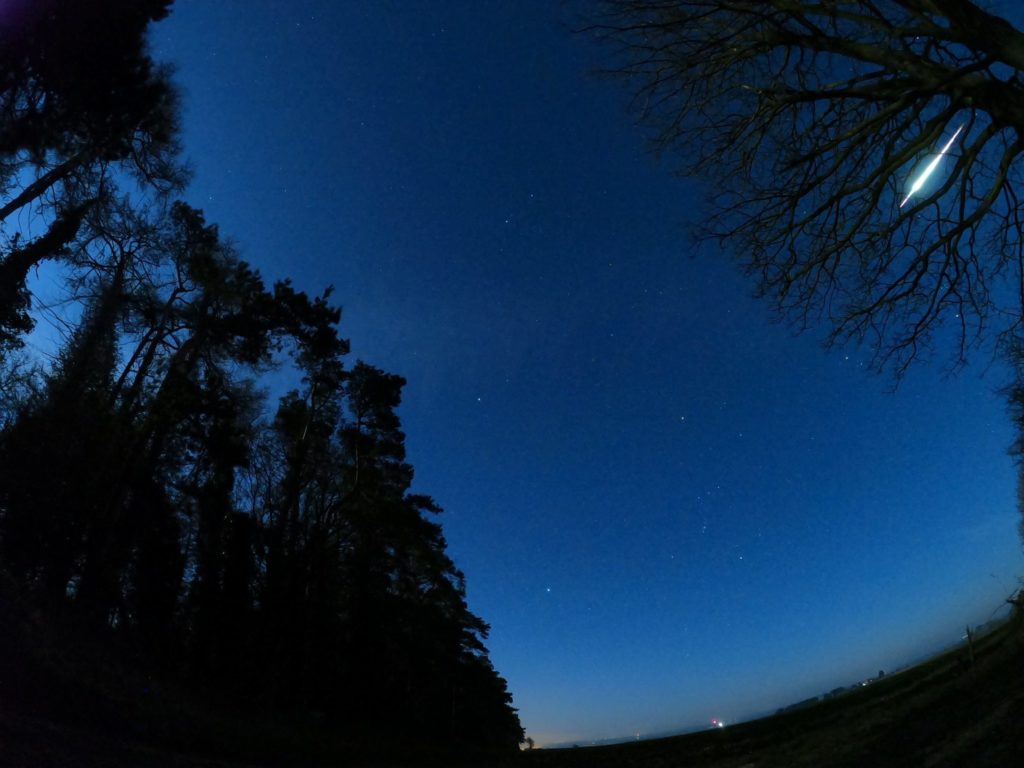
The bolide above the Cotswolds captured by @PhotobyBen on 28 February (published 22:04 p.m.). Photo: PhotobyBen
Trajectory, photometry, and fragmentation of the Winchcombe meteorite fall reconstructed using a multi-network data set
Denis Vida et al. (26 September 2021, International Meteor Conference – 25th/26th September, 2021)
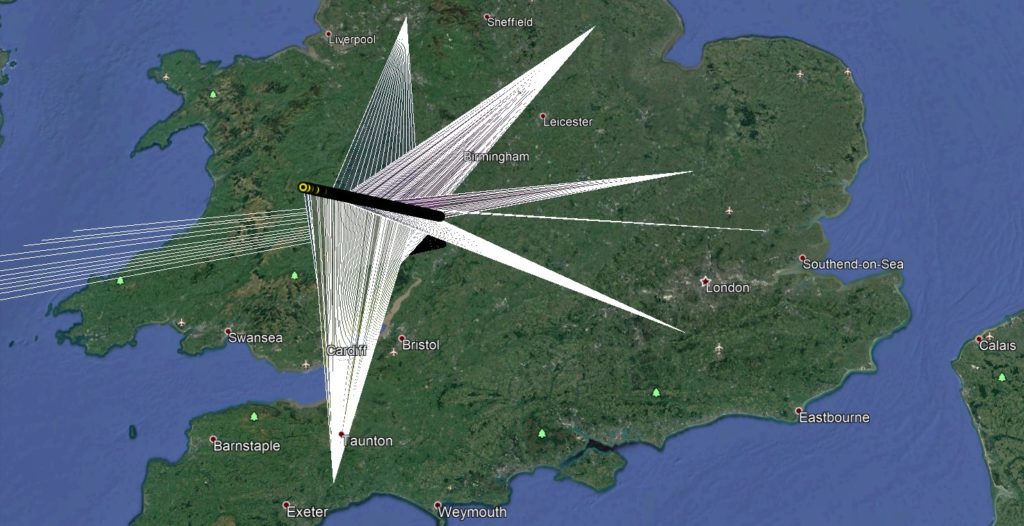
The bolide’s calculated atmospheric trajectory based on seven camera recordings from three camera networks: Manchester (SCAMP/FRIPON), Lincoln (UKFN), Cambridge (UKFN), Chelmsford (NEMETODE), Cardiff (SCAMP/FRIPON), Effingham (UKFN) and Honiton (SCAMP/FRIPON). Photo: Dr Hadrien Devillepoix
48-year old Alex Stoneman and Billy-Jay Stoneman’s security camera videos of the bolide, taken from Alex’s workplace in Midsomer Norton and their private camera in Bath, Somerset. The Bath camera had been installed only a week before the capture. Video: Alex Stoneman
The bolide captured with Richard Fleet’s camera in Wilcot (Wiltshire). Video: Richard Fleet, UK Meteor Observation Network camera
Video from north of Prestbury. Video: Joshua A.
Video: Michael Reeve, Burbage, Leicestershire
Video from Wrecclesham, Surrey. Video: Lee M.
Recorded in the southwest with AMS100 Nuneaton camera 4 from location 52.52638889°, -1.45472222°. Video: Ben Stanley
Video: ElliotTheUnread (28 February 2021)
Video: John Maher
Video from Loughborough. Camera data: Watec 902 HS with 6 mm f1.2 Cosmicar lens. Diffraction grating 500 lines/mm. (file ref. M20210228 215416 Loughborou SW). “The camera is fitted with a diffraction grating that splits up the light into a spectrum of different wavelengths which are due to the presence of excited atoms in the fireball. It is similar to a firework made of different chemical compounds to produce a range of colours e.g., sodium (yellow), calcium (purple – red), magnesium (green), iron (blue). The brightest parts of the video spectrum are due to calcium, iron, magnesium and sodium. This video locks onto the light from the four elements and tracks their intensities with flight time from start to end. A number of peaks signify abrupt changes in brightness due to in flight explosions.” Video (published 21 June 2021): East Anglian Astrophysical Research Organisation (EAARO) / Derek Robson
Video from Loughborough. Camera data: Watec 902 HS with 6 mm f1.2 Cosmicar lens. Diffraction grating 500 lines/mm. (file ref. M20210228 215416 Loughborou SW). Video: Derek Robson
The bolide recorded with the SCAMP/FRIPON cameras in Cardiff, Manchester and Honiton. Photos: SCAMP/FRIPON

The bolide recorded in a 30-second exposure photo of the Guildford camera in Surrey. Photo: UK Fireball Network/DFN
Video: Sam Clegg
Bolide captured by Ivor Lafford from Milton Keynes (“Nearby Old Farm Park SE corner”). Video: Ivor Lafford
Atmospheric trajectory and preatmospheric orbit
The 12.5 ± 3-kilogram meteoroid (azimuth: 263.342°) entered the atmosphere with a speed of about 13.547 km/s. The bolide with an observed length of 96.60 km was observed for 8.24 seconds from above location 51.87106 ± 29 m, -3.10932 ± 17 m (height: 90.623 ± 38 m) to location 51.94011 ± 33 m, -2.09634 ± 11 m (height: 27.554 ± 28 m). The observed velocity at termination point (27.554 ± 28 m) was about 3 km/s. The bolide reached its peak magnitude of -10.5 M at a height of 53-55 km. The peak dynamic pressure of 0.6 MPa was reached at 33.7 km. The radiated energy was 2.2 × 10 7 J (0.005 T TNT).
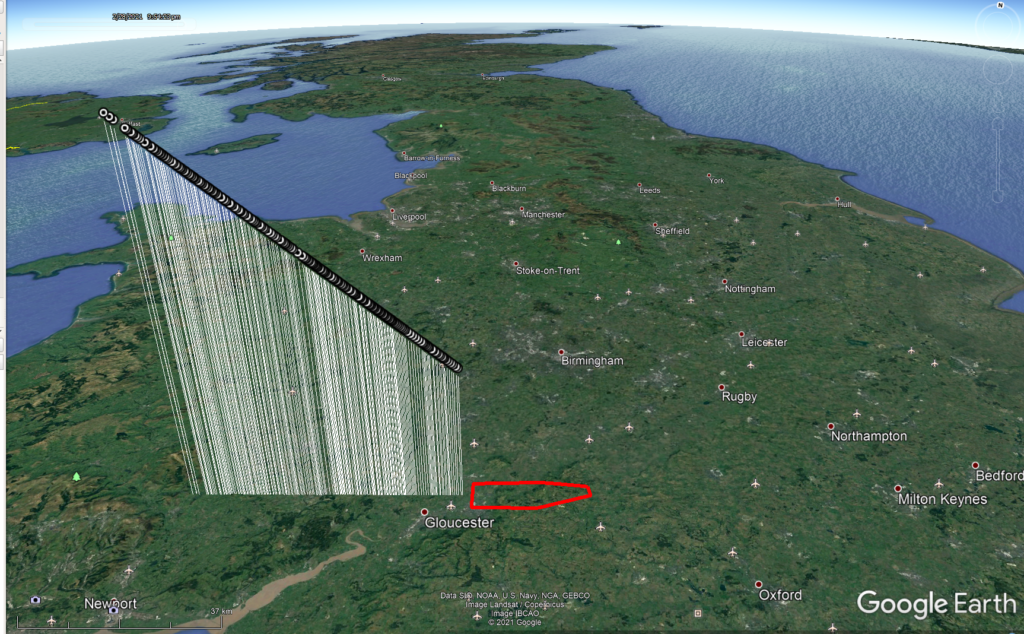
The luminous trajectory and the initial potential 300 square kilometre strewn field as determined by UK Fireball Alliance. Later the strewn field calculation was refined by a team of researchers from Curtin University (including Dr Hadrien Devillepoix) in Australia resulting in a ~6.5-km² potential strewn field which was then searched by scientists from different universities. Image: UKMON/Jim Rowe (UKFall)
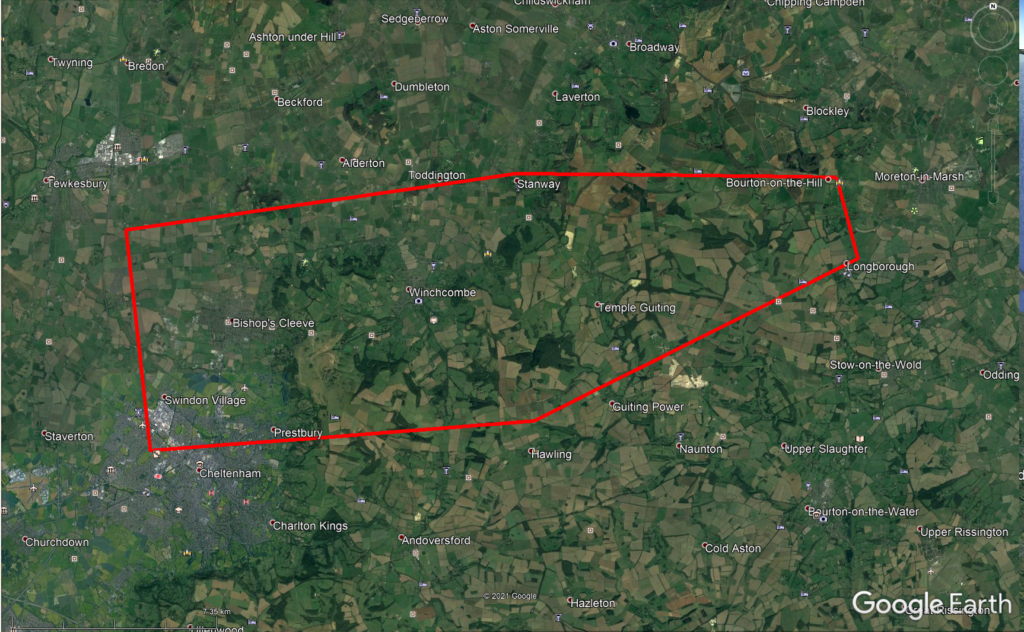
The initial and very roughly calculated potential 300-square kilometre strewn field as determined by UK Fireball Alliance. Later the strewn field calculation was refined a team of researchers from Curtin University (including Dr Hadrien Devillepoix) in Australia resulting in a ~6.5-km² potential strewn field which was then searched by scientists from different universities. Image: UKMON/Jim Rowe (UKFall)
Currently know orbital data, based on Denis Vida et al. (26 September 2021, International Meteor Conference – 25th/26th September, 2021)
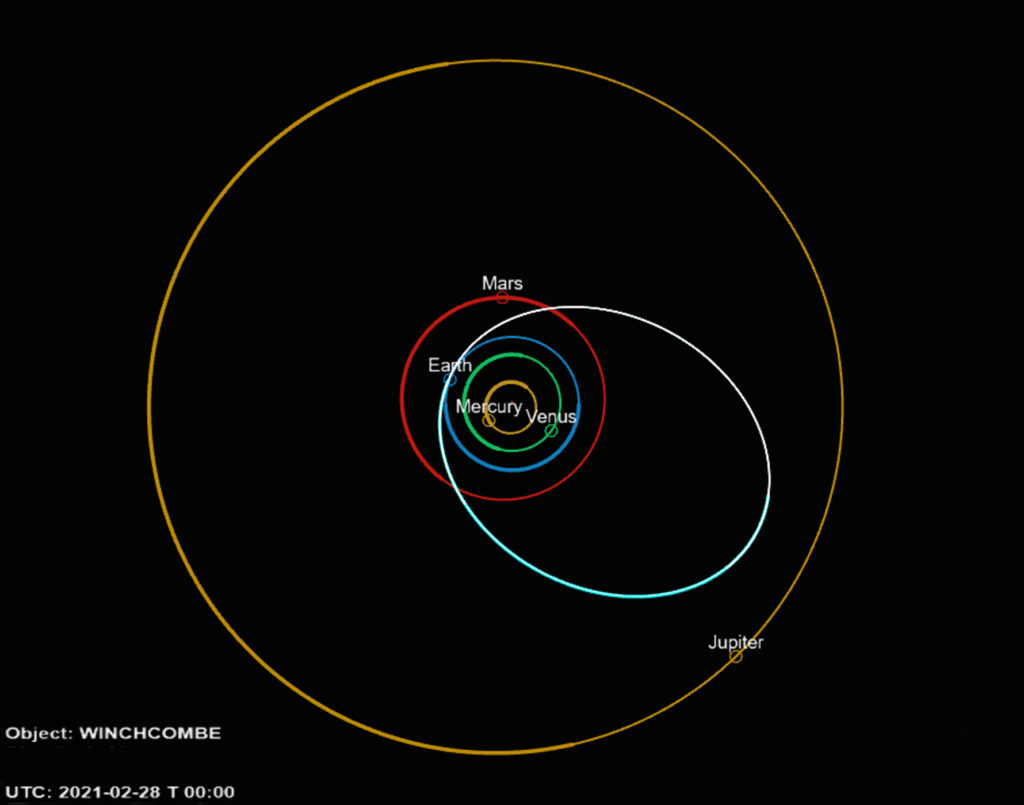
Orbital Data (J2000.0)
| a (AU) | 2.5855 ± 0.0077 | ω (°) | 351.798 ± 0.018 |
| e | 0.6183 ± 0.0011 | Ω (°) | 160.1955 ± 0.0014 |
| q (AU) | 0.986839 ± 0.000012 | i (°) | 0.460 ± 0.014 |
| Q (AU) | 4.184 ± 0.015 | TJ | 3.1207 ± 0.0056 |
Radiant Data (J2000.0)
| Observed | Geocentric | Heliocentric | |
| Right ascension (°) | — | 56.638 ± 0.017 | — |
| Declination (°) | — | +17.713 ± 0.069 | — |
| Ecliptical longitude (°) | — | — | — |
| Ecliptical latitude (°) | — | — | — |
| Initial velocity (km/s) | 13.547± 0.008 | 8.123 ± 0.013 | — |
Q = Aphelion, q = Perihelion, a = Semi-major axis, e = Eccentricity, i = Inclination, Ω = Ascending node longitude, ω = Argument of perihelion, TJ = Tisserand’s parameter with respect to Jupiter

BELOW: An early calculation of the Winchcombe meteoroid’s preatmospheric orbit, as determined by Fripon/Vigie-Ciel. The orbit calculation has meanwhile been refined, so that it seems that the preatmospheric orbit has an aphelion in the outer asteroid belt. So the meteoroid does not come from the Jupiter Trojan (Greek camp) zone. Image: karmaka

Strewnify’s calculations
Strewnify’s trajectory and strewn field calculations can be found here.
Strewnify’s maps as Google Earth files: KMZ (Version 2) / KML (Version 2)
MEDIA
Microscopy LIVE! Winchcombe Meteorite
Plymouth Electron Microscopy Centre , 25 February 2022 (11:00–12:00)
The Winchcombe Meteorite: one year on
Áine Clare O’Brien, Annemarie Pickersgill, Luke Daly, Laura Jenkins, Cameron Floyd, Pierre-Etienne Martin, Lydia Jane Hallis, Ashley King, Martin Lee
Astronomy & Geophysics, Volume 63, Issue 1, February 2022, Pages 1.21–1.23
Gloucestershire’s meteorite (BBC Radio Gloucestershire Special) (31 December 2021)
(Available until the end of January 2022)
Winchcombe meteorite driveway to go on display (BBC, 8 September 2021)
Search for building blocks of life in 4.6 billion year old meteorite (30 June 2021)
The Wilcock family has created their own Winchcombe Meteorite website on the meteorite fall.
Míra Bianka Ihász is talking about finding the ~150-gram mass in an interview with the Hungarian RTL Magyarország on 16 May 2021
Winchcombe meteorite to go on display at the Museum (NHM, 14 May 2021)
Interview (25 April 2021) with the Wilcock family about how they found their meteorite. Video: Topherspin
In the The One Show on BBC (15th April 2021) the Wilcocks and the Carricks were interviewed about their finds.
Winchcombe’s meteorite
an edited version of a zoom meeting on the 22nd March 2021 (edited for Radio Winchcombe)
Participants: locals from Winchcombe, the Wilcock family, Dr. Ashley King, Dr. Helena Bates, Prof. Sara Russell and Dr. Richard Greenwood
The Winchcombe meteorite was featured in a 9-minute segment of ‘The Sky at Night’ episode Mars and Meteorites, broadcasted at 9.30 p.m. on 11 April 2021 on BBC Four.
The project ‘The Television of Cruelty’ of Winchcombe resident Ian Williams has produced a song about the Winchcombe meteorite fall, which was published in early April 2021. AUDIO and AUDIO 2
“The Winchcombe Meteorite
In the sky a fireball appears
It’s been travelling 4 billion years
From Jupiter and Mars it came
Across the blackness of deep space
Towards our little Cotswold town it steers…
Chorus
It went ‘cross the sky like a blinding light
It landed with a bang and gave her a fright
The little pile of ashes on the drive
Was the Winchcombe Meteorite, oh!
The Winchcombe Meteorite
Older than the Earth, it just falls down
Amino acids and organic compounds
We were all tucked up in bed
As towards us debris sped
When a space rock fell onto our town…”
Catching a Shooting Star – Pythagoras’ Trousers podcast
Dr Martin Suttle and Dr Helena Bates interviewed
30 March 2021 (and shortened in Pythagoras’ Trousers, Radio Cardiff on 2 April 2021)
Radio Winchcombe broadcasted interviews with the Wilcock family, Ashley J. King and Adam Hart in a special Winchcombe Meteorite ‘Science Hour’ on 17 March 2021 (and in excerpts on 14-15 March).
A shooting star parked on your driveway (MP3 download/audio stream)
Interview with Sara Russell, Science in Action, BBC (11 March 2021)
Interview with Áine O’Brien of the University of Glasgow
Physics World Weekly Podcast (11 March 2021)
Interview with Rob Wilcock about how the meteorite was discovered.
BBC (9 March 2021)
A team of UK scientists, guided by meteor specialists, have recovered pieces of an extremely rare meteorite, a type which has never fallen anywhere in the UK before Natural History Museum ( Press release, 9 March 2021)
Fireball meteorite that blazed across the UK recovered from a driveway NHM (9 March 2021)
Extremely rare fireball meteorite found: First of its kind ever recovered in UK Imperial College London (9 March 2021)
Unimaginable: The first scientist to confirm and identify extremely rare meteorite that fell to Earth The Open University (9 March 2021)
UofG researchers aid in historic meteorite recovery University of Glasgow (9 March 2021)
Winchcombe meteorite is first UK find in 30 years BBC (9 March 2021)
University researcher helps to recover first meteorite found in UK for 30 years University of Plymouth (9 March 2021)
Rare carbonaceous chondrite meteorite recovered UKMON (8 March 2021)
Fireball meteor 28 FEB 2021 at 9:54 pm UKMON (1 March 2021)
The Cosmic Cast – Interview with Dr. Ashley King (24 March 2021)
Space rocks on Earth – recovering a meteorite in the UK (9 March 2021)
Natalie Starkey, Monica Grady, Richard Greenwood, Ian Franchi, Mahesh Anand and Ross Findlay discussing the meteorite recovery efforts.


